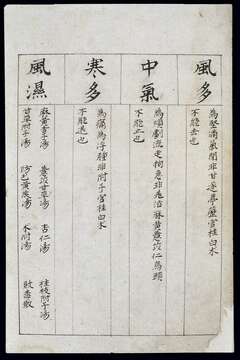C14 Chinese medication chart; Excess wind etc. Wellcome L0039605

Description:
C14 Chinese medication chart: Excess wind etc. Title: C14 Chinese medication chart: Excess wind etc. Description: Medication chart: Excess wind, middle Qi, excess cold and wind-damp syndromes. From a manuscript copy ofShanghan diandian jin shu(The Gold-dust Book of Cold Damage) dated '1st year of the Zhengyuan reign period of the Yuan dynasty' (1341), section entitledShanghan diandian jin yongyao muji(Cold Damage Gold-Dust Repertory of Medication).The text states: In case of stubborn fullness (jianman) and Qi blockage (qi bi) due to excess wind, one cannot get rid of the disease unless one uses [root of] Euphorbia Kansui (gansui), draba nemorosa (tingli), cassia bark (guan gui) or atractylodes macrocephala (baizhu).In case of distress (fan), and muscular stiffness and tightness experienced when walking (liuzou juji), due to middle Qi manifesting, it cannot be cured except with notopterygium rhizome/root (qianghuo), ephedra (mahuang), Job's tears seed (yiyi ren) or monkshood (wutou).In case of pain and oedema (fuzhong) due to excess cold, the illness will not abate unless aconite (fuzi), cassia bark (guan gui) or atractylodes macrocephala (baizhu) is used.For wind-damp (fenghi) conditions, common prescriptions are ephedra and apricot decoction (mahuang xingzi tang), Job's tears and liquorice decoction (yiyi gancao tang), apricot kernel/almond decoction (xingren tang), cassia twig and aconite decoction (guizhi fuzi tang), liquorice and aconite decoction(gancao fuzi tang), stephania tetrandra and astragalus root decoction (fangji huangqi tang), atractylodes and aconite decoction (zhu fu tang), Detoxicating powder (baidu san), etc.Illustrated manuscript. Credit line: : This file comes from Wellcome Images, a website operated by Wellcome Trust, a global charitable foundation based in the United Kingdom. Refer to Wellcome blog post (archive).This tag does not indicate the copyright status of the attached work. A normal copyright tag is still required. See Commons:Licensing.. Notes: Wellcome Images Keywords: Chinese Medicine, TCM, Medicine, Chinese Traditional, Drug Therapy. References: Library reference: External Reference Wang Shumin II 306, External Reference Chen 23/1445 Qiu 306 and External Reference Vivienne Lo Photo number: L0039605. Source/Photographer: https://wellcomeimages.org/indexplus/obf_images/b8/bb/2bc8beb4618bc478a8b318f8f47d.jpg (hi-res image) Gallery: https://wellcomeimages.org/indexplus/image/L0039605.html Wellcome Collection gallery (2018-03-27): https://wellcomecollection.org/works/ewdqmgme CC-BY-4.0. Licensing[edit].mw-parser-output.responsive-license-cc{clear:both;text-align:center;box-sizing:border-box;width:100%;justify-content:space-around;align-items:center;margin:0.5em auto;background-color:#f9f9f9;border:2px solid #e0e0e0;border-spacing:8px;display:flex}.mw-parser-output.responsive-license-cc div{margin:4px}.mw-parser-output.rlicense-text div{margin:0.5em auto}@media screen and (max-width:640px){.mw-parser-output.responsive-license-cc{flex-flow:column}.mw-parser-output.rlicense-text{order:1}} This file is licensed under the Creative Commons Attribution 4.0 International license. You are free: to share – to copy, distribute and transmit the work to remix – to adapt the work Under the following conditions: attribution – You must give appropriate credit, provide a link to the license, and indicate if changes were made. You may do so in any reasonable manner, but not in any way that suggests the licensor endorses you or your use. https://creativecommons.org/licenses/by/4.0CC BY 4.0 Creative Commons Attribution 4.0 truetrue
Included On The Following Pages:
- Life (creatures)
- Cellular (cellular organisms)
- Eukaryota (eukaryotes)
- Archaeplastida (plants)
- Chloroplastida (green plants)
- Streptophyta
- Embryophytes
- Tracheophyta (ferns)
- Spermatophytes (seed plants)
- Angiosperms (Dicotyledons)
- Eudicots
- Ranunculales (Red Columbine)
- Menispermaceae (moonseed family)
- Stephania
- Stephania tetrandra
This image is not featured in any collections.
Source Information
- license
- cc-by-3.0
- source
- https://wellcomeimages.org/indexplus/obf_images/b8/bb/2bc8beb4618bc478a8b318f8f47d.jpg (hi-res image)
- photographer
- https://wellcomeimages
- original
- original media file
- visit source
- partner site
- Wikimedia Commons
- ID


